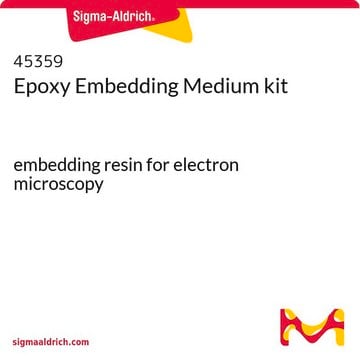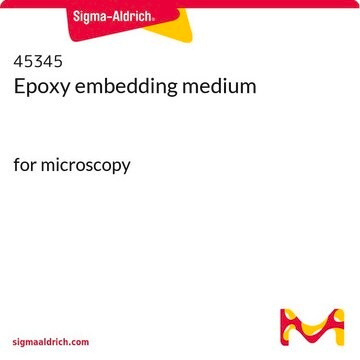추천 제품
일반 설명
Osmium tetroxide (OsO4) also referred to as osmium, is a heavy tetrahedral, symmetrical molecule. It is both a dye and a non-coagulant fixative agent in electron microscopy primarily used for the examination of biological tissue components in the histopathology laboratory. Specimens are postfixed with osmium tetroxide to ensure the preservation of the lipids.
생화학적/생리학적 작용
Osmium tetroxide is also referred to as osmium and is mainly used as a secondary fixative of tissues. The molecule reacts with lipid moieties and is responsible for the oxidation of unsaturated bonds of fatty acids. This reaction adds density and contrast to biological samples. In normal tissues, presence of osmium results in intense black staining which can be viewed by normal eye. In addition, it can be used as a mordant (a molecule which combines with stain or dye at later stages) in electron microscopy, thereby enhancing lead staining.[3]
신호어
Danger
유해 및 위험 성명서
Hazard Classifications
Acute Tox. 2 Dermal - Acute Tox. 4 Inhalation - Acute Tox. 4 Oral - Eye Dam. 1 - Skin Irrit. 2
Storage Class Code
6.1B - Non-combustible acute toxic Cat. 1 and 2 / very toxic hazardous materials
WGK
WGK 1
Flash Point (°F)
Not applicable
Flash Point (°C)
Not applicable
개인 보호 장비
Faceshields, Gloves, Goggles, type ABEK (EN14387) respirator filter
이미 열람한 고객
3-acetylpyridine-induced degeneration in the adult ascidian neural complex: Reactive and regenerative changes in glia and blood cells.
Medina BN, et al.
Developmental neurobiology, 75, 877-877 (2015)
Regulation of nitric-oxide production in hemocytes of the ascidian Phallusia nigra.
de Barros CM, et al.
Nitric Oxide, 38, 26-26 (2014)
Electron Microscopy: Principles and Techniques for Biologists (1999)
Bianca N S P Medina et al.
Developmental neurobiology, 75(8), 877-893 (2014-12-09)
Ascidians are interesting neurobiological models because of their evolutionary position as a sister-group of vertebrates and the high regenerative capacity of their central nervous system (CNS). We investigated the degeneration and regeneration of the cerebral ganglion complex of the ascidian
Carsten Købler et al.
Analytical and bioanalytical chemistry, 406(16), 3863-3873 (2014-01-23)
Ultrastructural characterisation is important for understanding carbon nanotube (CNT) toxicity and how the CNTs interact with cells and tissues. The standard method for this involves using transmission electron microscopy (TEM). However, in particular, the sample preparation, using a microtome to
활성 필터
자사의 과학자팀은 생명 과학, 재료 과학, 화학 합성, 크로마토그래피, 분석 및 기타 많은 영역을 포함한 모든 과학 분야에 경험이 있습니다..
고객지원팀으로 연락바랍니다.






